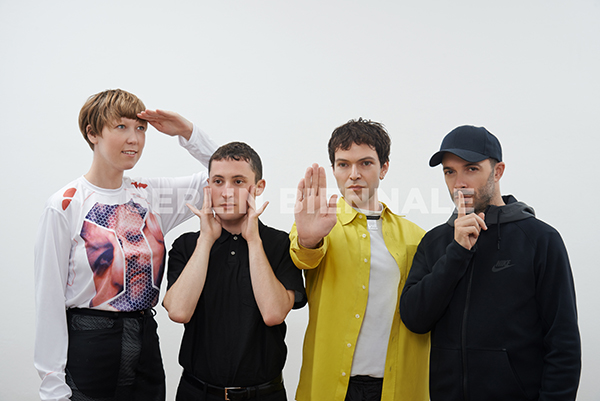Today it cannot come as a surprise if curators work in similar ways to artists. We are not shocked if the curatorial decisions and selections of artworks are based on the curators’ personal passions and fascinations for certain themes, materials, aesthetics or individuals. The contemporary viewer is namely always already aware that curators create the context in which contemporary art is presented. Moreover, we are always aware that such contexts are created from a particular standpoint, which is forced upon the curators’ class, sexual orientation and gender, or geographic origin.
In fact, one would be rather disappointed if curators were to try to be neutral and purely objective as one might feel the lack of subjective desire, belief, critical reflection and commitment. Thus at first glance, one cannot be surprised if the New York collective DIS, known for running the Internet-based DIS Magazine, has created a strong visual context for the 9th Berlin Biennale.
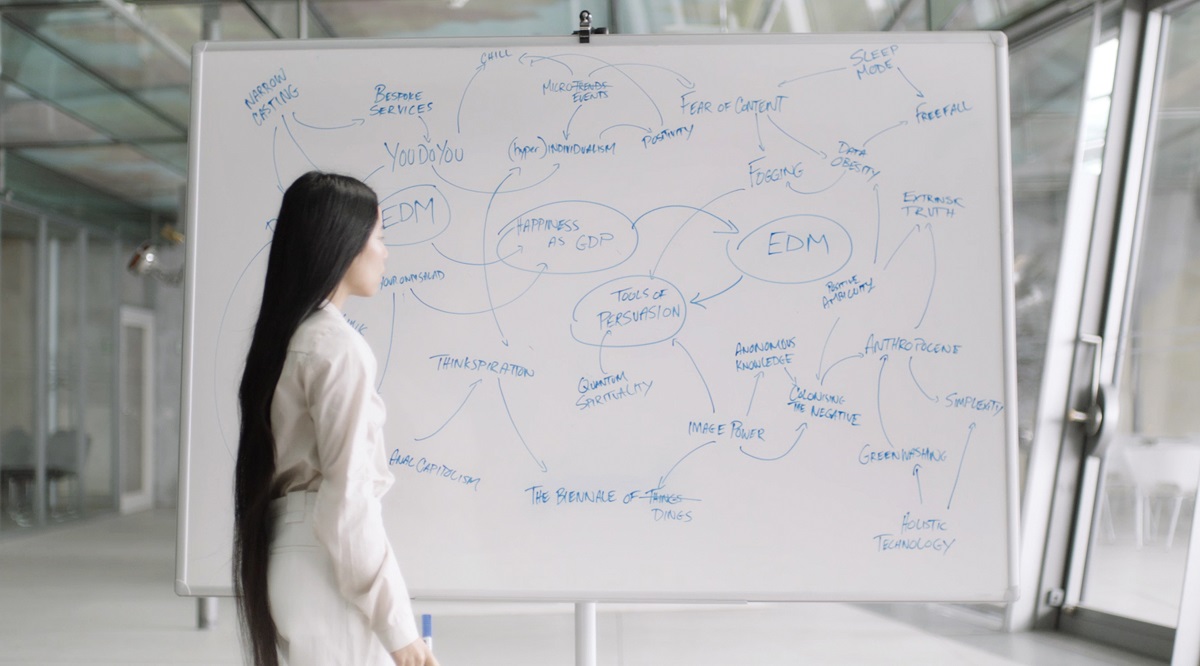
Before one has even entered any of the venues, one will have already passed by posters and billboards that announce the event and most likely one has also already visited the Biennale’s website. Thus, one has already been confronted with the corporate identity and branding as well as with the high-definition images and videos of happy, healthy and balanced faces that make up the visual advertisement campaign of this year’s Biennale. In other words, before one has entered any of the physical venues of the Biennale, one is already confronted with an interesting question: Do the curators want to criticize the increasing presence of corporate identities, or are they simply fascinated by their seductive power?
Yet, if one considers the corporate strategy and images more closely, one realizes that they are presented in such a simple, neutral and functional way that it is difficult—if not impossible—to come to a sufficient conclusion. Some of the stylized images depict young and fashionable people using futuristic looking high-end communication technologies, others show a seemingly heteronormative couple in a wedding dress and suit pictured in front of the various exhibition venues. The promotional videos one finds on the Biennale’s website leave a similar impression. One of these clips shows equally stylized scenes of a woman using an inhaler, branded with the Biennale’s logo, or another, writing on a whiteboard that shows diagrammatic networks, connecting recently hyped concepts like Anthropocene, Image Power, or Holistic Technology in a desperate attempt to come to terms with some of the contradictions that make up our contemporary reality.
Yet, the diagrammatic content map appears to be neither more nor less symptomatic and revealing than all of the other images. Nothing in these depictions of young and healthy, knowledgeable and communicative people in typical business settings is extraordinarily fashionable, beautiful or attractive, nor are they disturbing or upsetting; nothing in these images allows one to understand them as subjective expressions of a passionate and reflected critique.

Thus it is not surprising if the visual and communication strategy causes certain frustrations and disappointments on the side of the viewer. Visitors might very likely shift their attention to all of the possible subjects, problems, and conflicts that the image campaign and play with corporate identity are not depicting. Subjectively engaged and passionate curators could have dramatized, for example, the problems and conflicts that mark our time: new wars, ecological and humanitarian catastrophes like global warming or the refugee crisis, new class divides, new political extremism, or the decay of the EU.
Instead, it seems, that the curators chose to confront audiences with a number of exchangeable, insignificant images and identities without specific content. They give us pure surfaces as if they would be fascinated by the idea to run the Biennale like any other contemporary company. Accordingly, the Biennale also includes the distribution of merchandize at a pop-up store that, even if not in the Biennale, as communication rhetoric’s say, is still part of it and consists of a fashion line by TELFAR, contact lenses designed by Yngve Holen and a soundtrack produced by Total Freedom. The symbolic differences that until today allow us to differentiate the aestheticization of contemporary life by corporate business, in moral terms often understood as evil and seductive, and the art world, in moral terms often understood as good and critical, are rendered insignificant by the curators. And indeed, in this way, the viewer might be either morally frustrated about the shallow emptiness of our contemporary world, or about the seemingly shallow emptiness of the curatorial collective.

However, one should not overlook that these images as well as the whole visual campaign do obviously appear within a context in which they naturally do not belong, in which they are alienated. And moreover, the curatorial choice of the exhibition sites within typically tourist and business zones even alienates the venues themselves. Compared to earlier Berlin Biennales that were set up in interesting, already forgotten places that allowed visitors to grasp the fascination for the myth of Berlin as a city with its creative and even subversive potentials and possibilities after the Cold War, the curators of this years Biennale are leading the viewer from the normal residential areas around Auguststraße that houses KW into highly frequented tourist zones in Berlin Mitte.
Before one enters the Akademie der Künste, one will be forced to pass by other tourists taking photographs in front of the Brandenburger Tor. Walking down from Unter den Linden one will pass by historical buildings like the Humboldt University, the Staatsoper, or the Berliner Dom until one arrives at The European School of Management and Technology in which one finds artworks by Simon Denny, the collective GCC and Katja Novitskova that present work that deals with the phantasms of global finance. Another small venue is outsourced to a double-decker tour boat that takes the viewer down the Spree on a tourist tour.
Indeed, as the curators made clear in several statements, they are overtly conscious that all of these buildings and sites are charged with history and ideology. The site of Akademie der Künste in front of the Brandenburger Tor, this unmistakable sign of a united free and liberal Germany, is surrounded by Frank Gehry’s bank building and the luxurious Hotel Adlon, as well as by the office of the weapons manufacturer Lockheed Martin and the US and British Embassies. It is surrounded, in other words, with connotations of power that either remain invisible or appear to be yet another exchangeable surface on tourist images. If one visits the European School of Management and Technology, one enters the former States Council Building of the GDR. In front of the building one finds the construction site for the Berlin Palace that, while simulating the old Wilhelmine castle, replaces the former Palace of the Republic. Both buildings, the new castle as the management school, signify the historical triumph of a feudalist past and future over the once utopian communist future that belongs now to the buried past. The viewer only sees surfaces of buildings, tourist masks, behind which the historical connotations and meanings are threatened to be lost.
In the context of contemporary art, this tourist topology appears, in the same way as the surfaces of the Biennale’s visual campaign, even more artificial, more empty and shallow than in their natural self-presence. One always already expects, as mentioned above, to be confronted with the curators’ subjective passions, political or moral standpoints or at least significant speculations that transcend the aestheticized surfaces of our everyday life. Thus, one cannot be surprised if the exchangeable, insignificant images and typical tourist and business neighborhoods are potentially causing an even higher emotional reaction in some viewers, equaling more frustrations and disappointments. In this regard, it has been argued, for example, that the transfer of these empty, discharged corporate aesthetics into the context of contemporary art, in which these empty sign-carriers are recharged with the emotional reactions, frustrations and disappointments is inherently cynical.
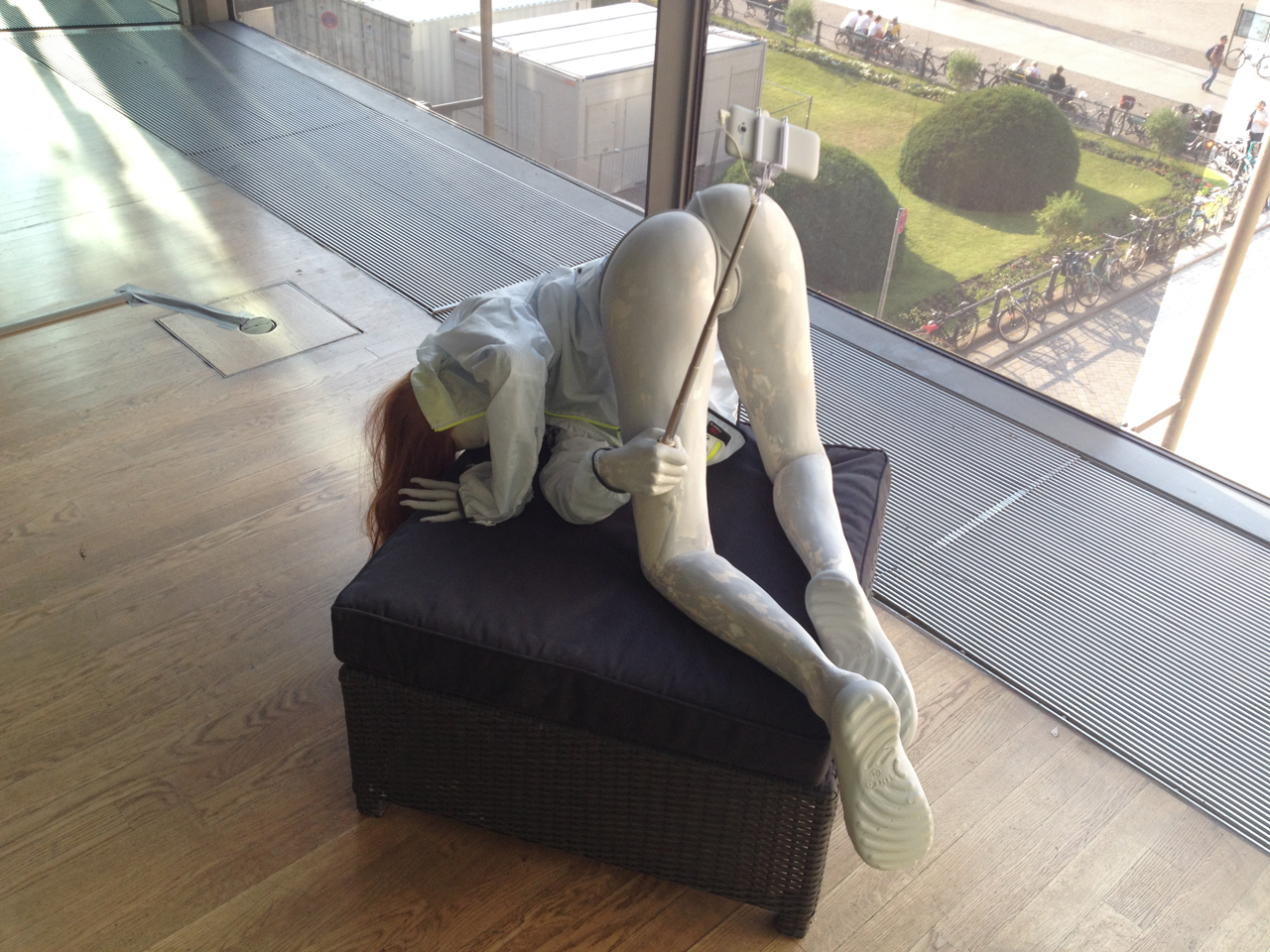
However one should not feel seduced to make such a conclusion. If the DIS collective’s curatorial strategy culminates in such a transfer, it obviously has a functional effect that could best be described as dis-identification and hence as an effect of a method that is known to deal with dominant ideology in such a way that it neither affirms its structure from within nor pretends to oppose it from a fictitious and superior outside. José Muñoz, the analyst of LGBTQ counter-culture movements, has discovered this method as the aesthetic principle of artists such as Jack Smith or Felix Gonzales-Torres. Their work is often celebrated for disturbing normative fantasies and identities, and this disturbing effect is created by the appropriation of normal and universally accessible images and visual narratives that circulated in popular culture, be it Hollywood movies, TV shows, or ad campaigns. They become queered and camped-up, and depending on the standpoint of the viewer, a source of different fantasies and pleasures, or of disturbing frustrations.
Indeed, one could easily argue that the shallow and empty corporate aesthetics do not look queer. And yet, on closer inspection, one understands that it is precisely the transfer of this corporate aesthetic into the context of contemporary art that creates a similar effect in the viewer, since it allows one to recognize the actual insignificance and emptiness, which, hence, creates the moral disturbances or frustrations in many viewers. It is due to this transfer that the images begin to appear as masks and costumes, which seem to hide nothing: Behind them one can find neither content, significance, nor referent—not even behind the material surfaces of the ideology and history-laden venues. Thus, one could argue that the Biennale really does show us, as its title suggest, the present in drag.
This sophisticated strategy obviously determines the curatorial choice of artists, many of who are operating with similar methods in order to play with the social construction of personal identities. This is most dramatically demonstrated in two video installations Mark Trade and Permission Streak (2016) by Lizzie Fitch and Ryan Trecartin. As in so many other works produced by these two artists, the videos feature groups of seemingly young and nervously excited people who appear with colorfully painted faces and wigs, constantly performing their shallow, content-free existence—and they appear to be shallow precisely because they have no identity, no existential essence, but only form, which they continually perform in front of the camera. Josh Kline uses face substitution software for Crying Games (2015) to replace the faces of his actors, with digitally rendered masks of George W. Bush, Tony Blair, Dick Cheney, Donald Rumsfeld, and Condoleezza Rice. The morally empty political strategists appear here in gray prison jump suits in order to deliver emotional laden content—apologies for their leading role in the US war on terror.
A similar play with identities is found in Transit Mode-Abenteuer (2014–16) by Anna Uddenberg, who camps and queers-up a whole number of shop window mannequins in such a sexualized and expressionist way that it becomes impossible once again to decide whether these puppets, merged at times with suitcases as if to underline their reification, are meant as critique or affirmation of sexualized stereotypes. And in Happy Museum (2016) Simon Fujiwara presents a collection of profane, everyday objects that range from asparaguses over trash can systems to a special make-up that, as a caption declares, is used by Germany’s chancellor to appear more natural on TV. These objects are masks of happiness, presented as total social facts, since we can assume that their selection is based on empirical data collected by a consultant agency that specializes in the quantification of happiness.
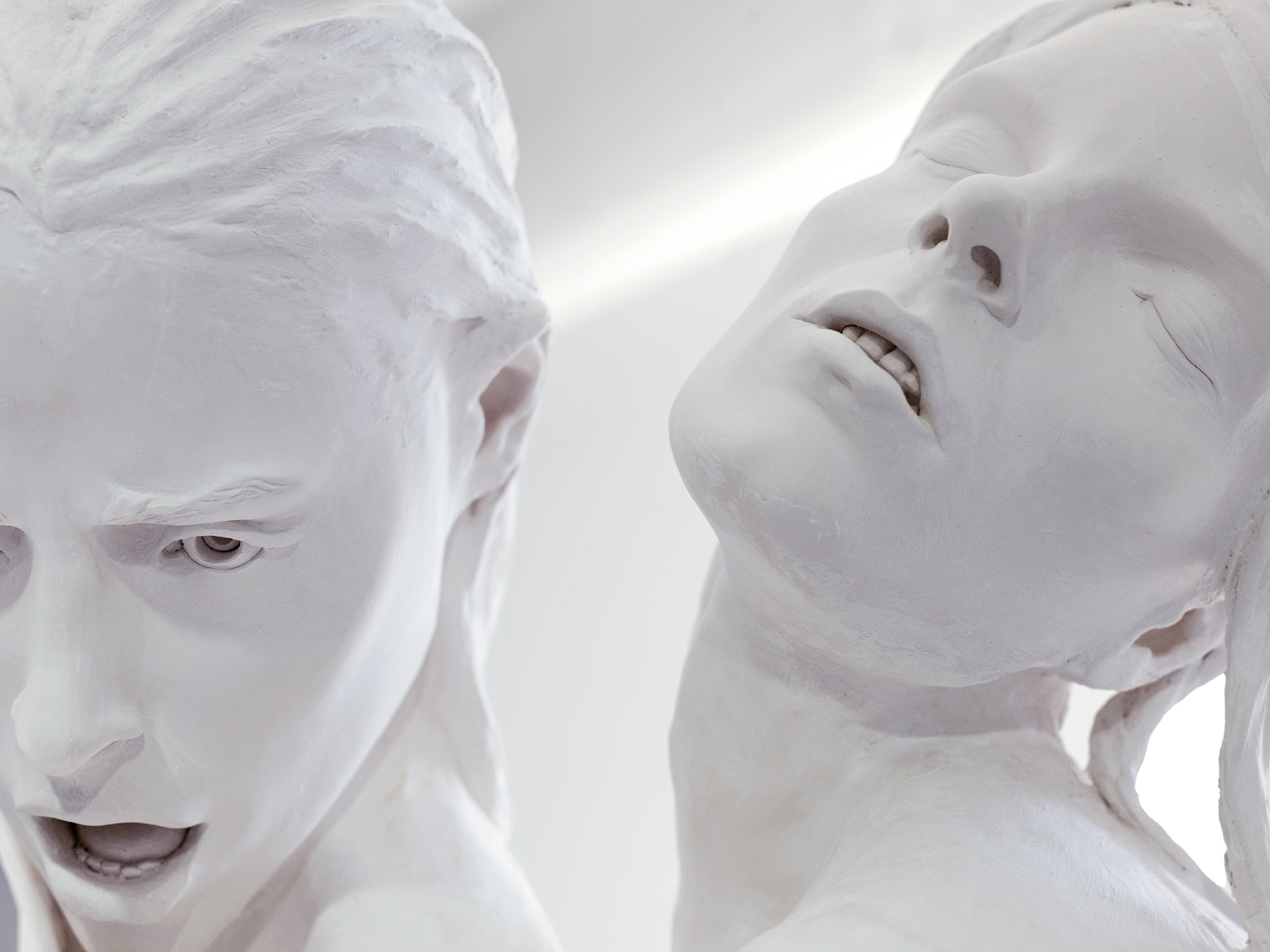
Indeed, these kinds of strategies are well known, analyzed and often associated not only with queer artists, but also with the so-called Pictures Generation in general. Yet, if one compares these contemporary forms of dis-identification with historical artistic productions of artists like Cindy Sherman, Richard Prince, and Barbara Kruger – artists whose work appeared first in the neo-conservative context of the 1970s and the US culture wars of the 1980s – one will necessarily recognize that their contemporary heirs produce much darker, insecure, and apocalyptic aesthetic effects. This is especially true in those cases where the visual high-def brightness seems to suggest cloned corporate surfaces without content and significance. One of the reasons for this difference can be certainly found in the fact that the method of dis-identification has become a new cultural normative force.
Today, in the age of the Internet, we find ourselves confronted with an ever-increasing number of heterogeneous images and fantasies than in the age of TV. All these images reflect, at least to a certain degree, the particular desires, wishes and fantasies of their producers and ensure their steady presence and constant circulation through the net. We are supposed to exist without identity, in ceaseless performance and medial presence. We do not only have the choice and possibility to freely play with all kinds of masks, identities and qualities, but rather our every day reality that is determined by digital technology and the internet forces us to do so. Besides, even the old TV media increasingly produce reality TV shows that appear as camp and queer insofar as the reality is always presented here as a staged reality in masks. And some shows, like RuPaul’s Drag Race, have established the phenomenon very explicitly and successfully within contemporary popular culture.
It is this dominant cultural normative force that the Berlin Biennial reflects through the lens of several contemporary artists and it has become clear today that its significance can be only grasped by its contradictory character. We are increasingly able to understand namely that it is precisely the playful use of different identities, of posting several private contents, political, moral, sexual and aesthetic opinions that makes us also predictable, because it lays bare the unconscious principles of our affections and desires that may not be consciously available to ourselves, but to the algorithms of the private and state corporations that measure us.
All of this doubtlessly leads to a kind of new existential despair that, as many the art works that are assembled in the context of the Biennial symptomatically show, forces us to revisit our mortal, stinking and error-prone bodies, but also to return to new fantasies of privacy and identity, since we feel urged to secure our unconscious identities with new codes, passwords and security services.
Thus, if the curators have selected artworks that can be easily subsumed under the well-known brand ‘post-internet’, their selection underlines what the brand has signified: The existential search to come to terms with a pluralistic and democratic cultural reality in which the experience of digital technology and the Internet has become a cultural norm. Under such cultural conditions the present is always already in drag and the Biennial thus confirms what theory and experience has often shown – the truth is a bitch that has reasons to evade judgment, measurement and control.
While queer and drag methods historically have a clear utopian and liberating potential insofar as they presented the possibility of deconstructing the culturally normative identities and ideals that the former conservative cultures have forced upon its individuals, today, in the context of digital mass culture, there is no conservative standard for images and fantasies. If at all, we are dealing with a new kind of norm of the Californian type.
The revolutionary content of this new dominant ideology consists of the dream of identities without essence, of vital affect bodies without subjectivity, but full of pure energetic presence and performance that is expressed in the form of ceaselessly self-optimizing bodies and creativity. It is for this reason that the curators also included artists like Nik Kosmas or Helga Wretman who perform these new normative ideals of self-optimization in an event series called Open Workout. And, the immaterial ideal of the Californian type is itself reflected and investigated by a number of artists like Débora Delmar Corp, Christopher Kulendram Thomas, or Sean Raspent.
The artist enterprise Débora Delmar Corp. produces the juice MINT, an acronym for the emerging global economies like Mexico, Indonesia, Nigeria, and Turkey. The drink can be purchased and consumed at a bar, which includes furniture and sculptures that simulate a typical hipster environment, which often also functions to simulate the morally valuable idea of green eco-sustainability. Since one does not only consume liquid fruit here, not even art, but the Californian dream of an aspirational, green, sustainable and healthy eco-lifestyle, the drink comes, not unlike real eco-smoothies, with a price. Christopher Kulendran Thomas replaces his artistic identity with a new entrepreneurial form of self-design. Thomas creates a promotional booth of a show home environment for his start-up New Eelam (2016), in which one finds a pseudo-documentary about Sri Lanka’s recent history that turns into a real-estate promotional video for luxury housing and a brochure that envisions a globalized future life without national borders, but only economic barriers that are marked by the free and happy exchange of goods and people.
Sean Raspet, who designs abstract flavor and chemically based formulations, works also for the California-based brand Soylent, which breaks down food into its basic structure in order to produce it in a more sustainable, rational and efficient manner. Raspet uses the Biennale to distribute 2000 samples of Soylent 0.10 and reminds the viewer and potential consumer that the remaining left-overs of bourgeois taste, which culminates in the desire for extravagant cuisine, wine and liquor, is historically as relative as the long gone bourgeois capability of aesthetic judgment in art.
The appreciation of food presupposes not only a naturalist and geographic referent like an exclusive Champagne, but, as the former appreciation of so-called high art, it affords most of all cultural discipline, training and repression in order to not only achieve an exclusive aesthetic judgment subjectively, but to rationally and objectively defend it culturally—it presupposes cultural techniques that, from an techno-utopian future perspective that Raspet represents here already as a profane Californian reality, seem increasingly outdated.
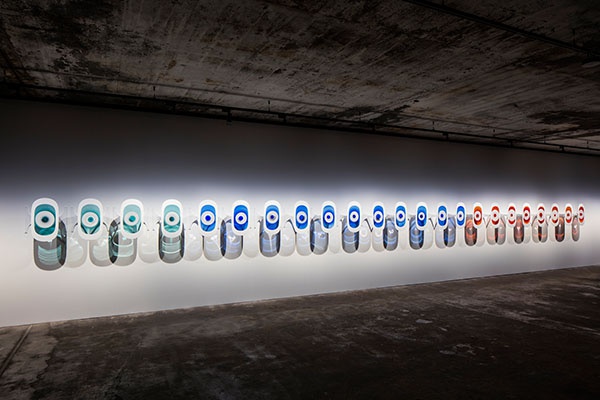
Thus, the DIS collective has indeed selected a number of artworks and positions that have been overly discussed in the last years, but it sets them up in such a context that the viewer must be necessarily morally frustrated about the shallow emptiness of our contemporary world, or about the seemingly shallow emptiness of the artists and curators one associates with the post-internet brand. It sets them up, in other words, that the viewer feels in total moral control over its effects. The only question remaining therefore is, why the curators feel the need to present art in such a moral way? The answer is clear: The world consists of a large number of problems that contradict the moral, humanist ideals we live by.
It is in this way that the real, objective problems appear to us as moral contradictions. And while most of the existing problems remain objectively unresolved, it seems possible to resolve the moral contradictions within our consciousness by becoming morally good, by using the right words, eating the right food, by respecting the others’ feelings, by creating safe spaces and morally good art. There is no point in questioning the noble cause of such attempts. At the same time, however, the history of Christianity has exemplarily assured us that it is impossible to reach moral perfection within the wrong world. Accordingly, it seems that we must reproduce the external contradiction that marks our reality within our inherently, morally divided, and contradictory selves.
It is in this way that the curatorial process evaluates the existential search for cultural significance of the so-called post-internet generation that has often been understood as empty hype or market-driven ideology as a valid, moral social practice. In a free adaption of Adorno who, in his Minima Moralia, has investigated a similar phenomenon, one can argue that what we had once called life has now turned into a sphere of digital networks of content distributions and then merely of users, which are dragged along as an attachment of the material production-process, without identity and without substance. Thus, it becomes possible to understand the return of the desire to search for the truth of immediate life beyond, which manifests as the moral force to investigate its empty digital image forms – the objective powers that determine the individual existence into its innermost recesses. The DIS collective surely belongs to the most interesting cultural producers who are devoted to the investigation of such contradictions, only that they drag up this sorrow science as gay science.


